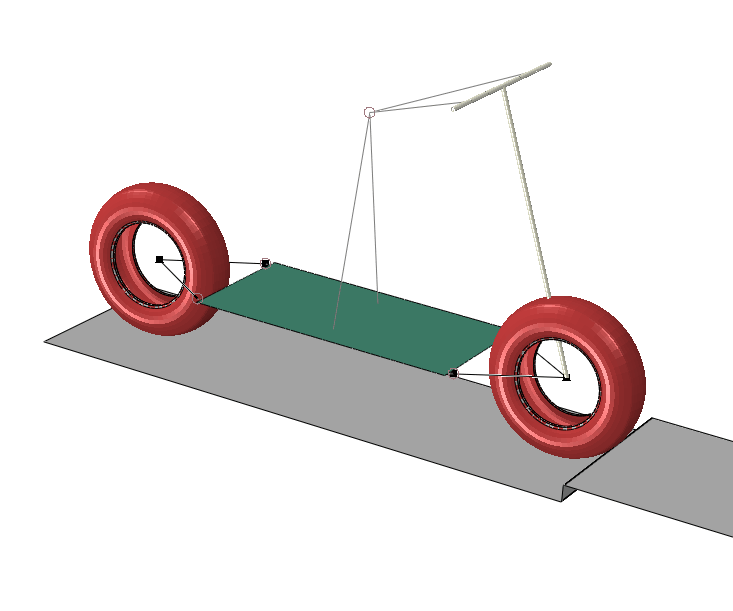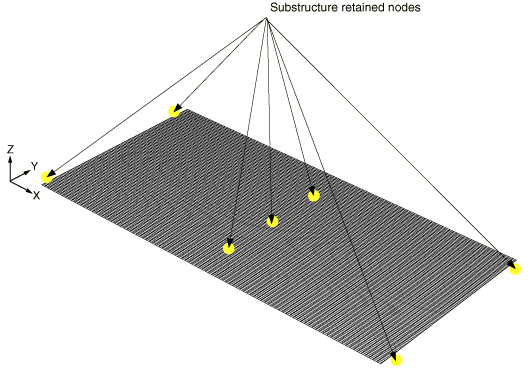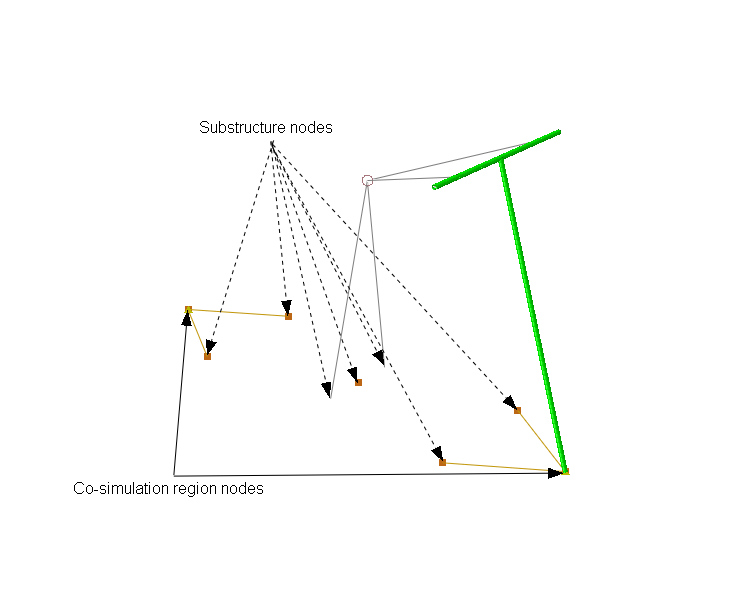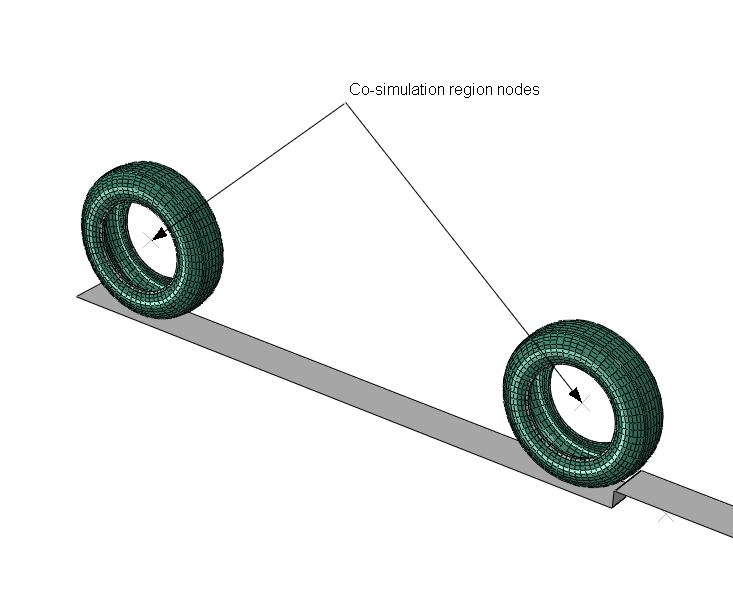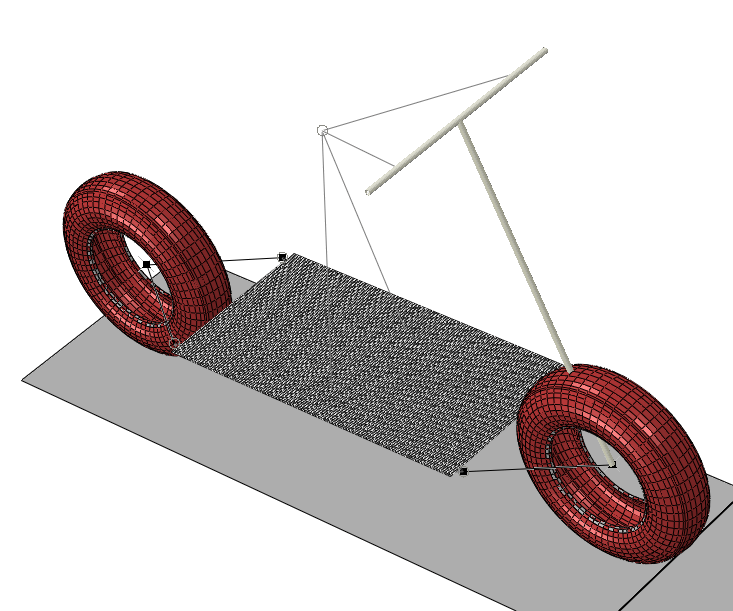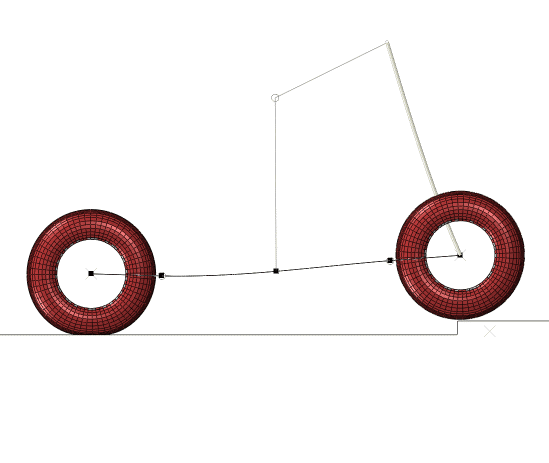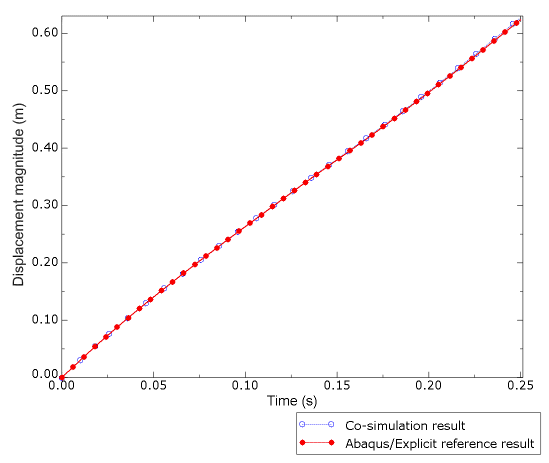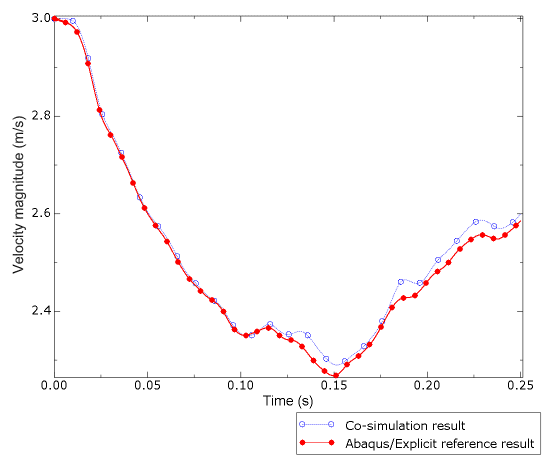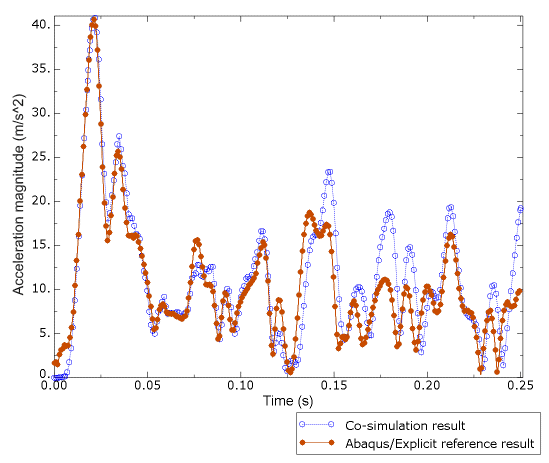Dynamic impact of a scooter with a bump | ||
| ||
ProductsAbaqus/StandardAbaqus/Explicit
Application description
This example considers the impact of a recreational scooter with a bump. An analysis of the transient response of an interaction with a bump is used to determine the accelerations felt by the scooter operator. With this analysis a product designer can make informed design decisions by varying certain design parameters, such as the frame component cross-section properties, tire material, or inflation pressure and observing their influence on the operator acceleration. Effective use of this simulation technique requires that the simulation turnaround time be as quick as possible while retaining essential fidelity in the results.
Geometry
The scooter consists of an operator deck, a frame with handlebars, and two tires, as shown in Figure 1. The overall length of the scooter is 1200 mm, and the overall height is 800 mm. The handlebars are oriented straight.
Materials
The scooter deck and frame tubing are made of mild steel. The tires are a Butyl rubber material.
Initial conditions
The simulation begins with the scooter having inflated tires and traveling toward the bump at a speed of 3 m/s.
Boundary conditions and loading
Weight loading is due to the scooter and the operator.
Interactions
The scooter travels on a rough surface. This surface includes a bump that is 7.5 cm high and is positioned in front of the scooter.
![]()
Abaqus modeling approaches and simulation techniques
Several Abaqus analysis approaches can be used to simulate the transient behavior of the scooter: using only Abaqus/Standard, using only Abaqus/Explicit, or using Abaqus/Standard to Abaqus/Explicit co-simulation. To illustrate the computational cost savings of the co-simulation approach, the analysis cases that follow focus on comparing the co-simulation approach to an Abaqus/Explicit-only simulation approach.
The Abaqus/Standard model of the co-simulation analysis consists of the scooter deck (Figure 2) and frame (Figure 3). The deck is modeled using substructure techniques to further reduce the solution cost. The Abaqus/Explicit model of the co-simulation analysis consists of the tires and the road with the bump (Figure 4). Co-simulation regions across which data will be exchanged during the co-simulation analysis are identified on each model at the location of the wheel axles.
Summary of analysis cases
| Case 1 | A reference analysis performed using only Abaqus/Explicit. |
| Case 2 | A co-simulation analysis using the subcyling coupling scheme. |
Both analysis cases address the same transient simulation.
Analysis types
The tire transient response and contact with the road are simulated using the explicit dynamics procedure. In Case 1 the explicit dynamics procedure applies to the rest of the model as well. The scooter frame transient response is simulated using the implicit dynamics procedure.
Analysis techniques
Static stabilization, substructuring, and import analysis techniques are used in this example.
Static stabilization
The inflation of the tires uses the Abaqus/Standard static stabilization option.
Substructuring
The scooter deck is expected to experience small strains during the analysis, allowing the use of a substructure to model the deck as a technique to lower computational cost.
Import
The tires are inflated in an Abaqus/Standard static procedure. The inflated state and configuration of the tires are imported into Abaqus/Explicit for the subsequent transient analysis.
Mesh design
The meshed models are shown in Figure 5. The frame components are modeled using truss and connector elements. The deck is modeled using S4R shell elements. The tires are modeled using C3D8I continuum elements. The operator is represented by a point mass connected to foot and hand-hold locations through a distributing coupling constraint definition.
Materials
The deck is modeled as a simple linear elastic material, with an elastic modulus of 5 GPa, a Poisson's ratio of 0.3, and a density of 5000 kg/m3.
The tires are modeled as a hyperelastic material with viscoelastic properties. The tire material density is 1100 kg/m3.
| Hyperelastic material constants | |
|---|---|
| 1 MPa | |
| 0.0 Pa | |
| 5.085 × 10−8 Pa | |
| Viscoelastic material constants | |
|---|---|
| 0.3 | |
| 0 | |
| 0.1 | |
Initial conditions
An initial tire pressure of 20 KPa is applied. The tires begin the analysis in a statically equilibrated footprint configuration as a result of import from an earlier static analysis. The scooter is traveling toward the bump at an initial velocity of 3 m/s.
Boundary conditions
The scooter steering assembly is fixed in a straight configuration.
Loads
Forces are applied consistent with a total scooter weight of 42.4 N and a total operator weight of 222 N. To simplify the analysis setup, gravity loading is not applied; instead, the weight forces are applied at the axle locations. The main consequence of this loading approach is that the static sag of the deck due to the operator is neglected.
Constraints
The scooter deck is attached to the frame using tie constraints.
Interactions
Contact interactions define the tire contact with the road and bump.
![]()
Case 1 Abaqus/Explicit reference analysis
This analysis case uses Abaqus/Explicit exclusively for the transient analysis and is provided as a reference for comparing the results and computational cost of the co-simulation solution.
Analysis types
Abaqus/Explicit is used for the transient analysis with the tire inflation occurring using the static procedure in Abaqus/Standard.
Analysis steps
The following analysis step types are used.
Static analysis
An Abaqus/Standard static procedure is used to inflate the tires and establish the tire footprint.
Explicit dynamics
The Abaqus/Explicit step does not employ mass scaling. The default bulk viscosity parameters are used.
Results and discussion
The simulation results show the scooter impacting the bump, the operator shifting forward slightly, and the deck flexing.
![]()
Case 2 Co-simulation analysis using subcycling
In this case co-simulation occurs between Abaqus/Standard and Abaqus/Explicit, with each program advancing its simulation time according to its own automatic incrementation scheme and exchanging data as needed. Co-simulation data are exchanged at each Abaqus/Explicit time increment.
Analysis types
Abaqus/Explicit is used for the transient analysis of the tires with the tire inflation occurring using the static procedure in Abaqus/Standard. Abaqus/Standard is used for the transient analysis of the scooter frame and deck.
Analysis steps
The following analysis step types are used.
Static analysis
An Abaqus/Standard static procedure is used to inflate the tires and establish the tire footprint.
Explicit dynamics
The Abaqus/Explicit step does not employ mass scaling. The default bulk viscosity parameters are used.
Substructure generation
The substructure generation of the scooter deck uses 100 retained eigmodes, obtained using the Lanczos eigensolver.
Implicit dynamics
The Abaqus/Standard transient dynamic steps use a half-increment residual limit setting of 200 N.
Solution controls
Co-simulation controls are used to specify a subcycling approach.
Run procedure
The analyses proceed in two stages. In the first stage a pair of jobs is run. One job creates a substructure matrix for the main structure:
abaqus job=scooter_subgen
A second job establishes the state of an inflated and seated tire:
abaqus job=scooter_tire_inflation
With the results from these two jobs available, the co-simulation job can be run, coupling the structure to two instances of the inflated tire. The coupling is achieved using the Abaqus co-simulation execution procedure (see Abaqus/Standard, Abaqus/Explicit, and FMU co-simulation execution).
For example, use the following command to run the Abaqus/Standard and Abaqus/Explicit jobs:
abaqus cosimulation cosimjob=scooter job=scooter_cosim_std,scooter_cosim_xpl oldjob=NONE,scooter_tire_inflation configure=scooter_cosim_config
Results and discussion
The results for a co-simulation analysis appear in multiple output files. To make effective use of the Abaqus/Standard and Abaqus/Explicit output databases, you should use the Abaqus/Viewer overlay functionality to view the combined results. For more information, see Overlaying multiple plots.
![]()
Discussion of results and comparison of cases
The results show that Case 1 is more computationally expensive. Case 2 provides a significant cost improvement. Further, the results show that the solution fidelity, when compared to the reference solution, is not significantly affected by the use of the co-simulation technique.
Final configuration of the assembly
As the scooter collides with the bump, the entire assembly leaves the ground and flexes slightly, as shown in Figure 6.
Dynamic response of the operator
We consider measures of operator comfort to relate to the displacement, velocity, and acceleration magnitude histories at the operator node location. Figure 7, Figure 8, and Figure 9 show these respective response histories, comparing the results for the Case 1 and Case 2 analyses. The results are plotted after applying the Butterworth filter with a cutoff frequency of 100 Hz (see Applying Butterworth filtering to an X–Y data object) and show very good agreement between the Case 1 and Case 2 workflows.
Computational cost
Table 1 lists the relative computation cost of the two simulation approaches and clearly shows the value of co-simulation in this analysis.
![]()
Files
Common files
- scooter_tire_inflation.inp
-
Abaqus/Standard input file to inflate the tires and establish the static footprint due to the assembly weight.
- scooter_parameters.inp
-
Job parameters common to all scooter analyses.
Case 1 Abaqus/Explicit reference analysis
- scooter_xpl.inp
-
Abaqus/Explicit input file to model all components, importing the inflated tires from scooter_tire_inflation.inp results and simulating the transient impact with the bump.
Case 2 Co-simulation analysis using subcycling
Co-simulation configuration- scooter_cosim_config.xml
-
Co-simulation configuration file defining the subcycling algorithm.
- scooter_cosim_xpl.inp
-
Abaqus/Explicit input file to model the tires and road, importing the inflated tires from scooter_tire_inflation.inp results and simulating the transient impact with the bump through co-simulation coupling with scooter_cosim_std.inp.
- scooter_subgen.inp
-
Abaqus/Standard input file modeling the deck and creating the substructure representation of the deck.
- scooter_cosim_std.inp
-
Abaqus/Standard input file modeling the frame components, referring to the scooter_subgen.inp substructure definition and simulating the transient impact with the bump through co-simulation coupling with scooter_cosim_xpl.inp.
![]()
Tables
| Analysis job | Relative CPU time | |
|---|---|---|
| Co-simulation workflow | Abaqus/Explicit workflow | |
| Substructure generation | 0.007 | N/A |
| Tire inflation and footprint | 0.002 | 0.002 |
| Co-simulation Abaqus/Explicit analysis | 0.060 | N/A |
| Co-simulation Abaqus/Standard analysis | 0.057 | N/A |
| Complete Abaqus/Explicit analysis | N/A | 1.0 |
| Total simulation cost | 0.126 | 1.002 |
![]()
Figures
